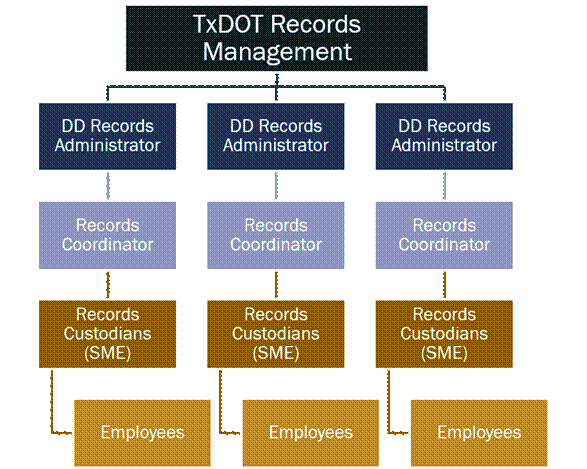Section 2: Objectives, Scope, Roles and Responsibilities
Anchor: #i1009175Objectives
Records Management consists of policies and procedures intended to:
- Anchor: #NCCYCASY
- Ensure compliance with records management laws and requirements. Anchor: #XWLGDHFS
- Reduce costs for maintaining official records. Anchor: #AGRRWLOA
- Manage risks related to records.
In addition to assuring legal compliance, records management reduces costs for physical and electronic record keeping resources by controlling volumes and promoting efficient organization and management of active and inactive files for retrieval.
CAUTION: Records management helps manage legal risks that can result from maintaining outdated records. An approved Records Retention Schedule provides legal authority to destroy records when their required retention period has been met.
Anchor: #i1009223Scope
The scope of TxDOT’s Records Management Program includes:
- Anchor: #MKNYUUKI
- Developing and maintaining a Records Retention Schedule approved by the State Auditor and the Texas State Library and Archives Commission. Anchor: #LKVRKAPT
- Developing and publishing records management procedures. Anchor: #UYTABTIC
- Providing guidance and assistance to help department offices manage records efficiently and in compliance with the requirements of statute and department policy, Anchor: #VQDSBJSO
- Coordinating the retention and disposition of official TxDOT records in accordance with approved retention policy.
Program Responsibilities
The Records Management Program is responsible for:
- Anchor: #TCAMKBKH
- Researching, developing, and recommending records management policies to management. Anchor: #UPBCSIOJ
- Maintaining a current, approved Records Retention Schedule. Anchor: #HLPMCYAC
- Oversight and monitoring program compliance by Districts and Divisions. Anchor: #EDXUCMXV
- Coordinating TxDOT's Records Management Program with outside agencies as required. Anchor: #MLUAOKCQ
- Maintaining current procedures in the Records Management Manual and disseminating program information on the intranet. Anchor: #FBLVLWDU
- Training, assisting, and consulting with department offices on records management methods, practices, and requirements. Anchor: #PYNNPBME
- Managing records storage for headquarters divisions and offices. Anchor: #ANIDPHCA
- Maintaining required program records.
Program Responsibilities of Districts and Divisions
Districts and Divisions are responsible for:
- Anchor: #IODKHYCI
- Compliance with TxDOT records management policies. Anchor: #NMBAKDSJ
- Implementing TxDOT records management
procedures, including:
- Anchor: #FPLEKGWA
- Developing and maintaining office or work unit File Plans. Anchor: #XKGQBHBH
- Identifying vital records and taking measures to protect them. Anchor: #MVTLVWRM
- Retaining official records for the required retention period, whether locally or in remote storage facilities. Anchor: #RVKQXEEP
- Coordinating the timely disposition and destruction of records when they become eligible and submitting the required record destruction documentation to TxDOT records management.
Records Management Roles and Responsibilities
Texas State Library and Archives Commission, also known as “The Commission” - is the governing body over records management for state and local agencies. Texas State Library and Archives Commission approves TxDOT’s Records Retention Schedule and provides records management support and guidance to the agency. Texas State Library and Archives Commission is designated as the State and Local Records Management Division (SLRM). Responsibilities include providing an infrastructure for managing Texas public records by assisting state and local officials with training, resources, guidelines, and consultation to ensure government information is stored, retained, and made accessible.
TxDOT Records Management Officer is designated by the Executive Director as the TxDOT Records Management Officer for coordinating the program with the Texas State Library and Archives Commission. Responsibilities include establishing expectations, accountability, development, management, implementation, and administration of standardized internal procedures of the Records Management Program to ensure consistent compliance with the requirements of Texas Government Code §441.183 et. seq. and Texas Administrative Code 13 TAC §6.
TxDOT Records Manager is designated by the Records Management Officer. The Records Manager is responsible for the administration, oversight, and adherence to the Records Management Program for TxDOT. This includes the certification of the Records Retention Schedule at least every five (5) years, ongoing training and communication with the Districts and Division Record Administrators, Record Coordinators and Record Custodians. The Records Manager is responsible for providing consultation to and soliciting feedback and advice from the Records Management Officer, Records Administrators and Records Coordinators.
TxDOT Records Management Warehouse Coordinator – is responsible for managing the retention of the physical official records stored at TxDOT’s Records Management Warehouse. Coordinator also manages District and Division requests for transfer, destruction, and onsite access of physical official records.
District and Divisions Records Administrators (RAs) are appointed by the district engineers, division, and office directors to implement and manage the records management program in their respective organizations. This includes the development and maintenance of work unit File Plans, coordination and management of routine periodic procedures, oversight, and annual submission of current File Plans, as well as the verification of the records retention and destruction authorizations of records with supporting documentation as provided by Records Custodians.
District and Divisions Records Coordinators (RCs) are designated employees who perform recordkeeping tasks under the direction of the Records Administrators for both physical and digital file management. Records Coordinators are accountable for securing and disposing of records and information in their custody and control. This includes the creation, monitoring, and maintenance of the work unit File Plan, records storage, records eligible for destruction, and documenting records for destruction by completing Forms 1420 “Records Destruction”, and 1419 “Records Transmittal” with proper approvals/signatures for execution.
District and Divisions Records Custodians are Subject Matter Experts responsible for official records related to their respective functional areas or work units/offices. Subject Matter Experts are responsible for the effective collaboration with Records Administrators and Records Coordinators to ensure records are properly classified per the Records Retention Schedule and dispositioned according to TxDOT policies, standards, and processes.
Office of Primary Responsibility (OPR) is the organizational unit or individual(s) responsible for the creation, disposition, and destruction of the official record when retention has been met. Offices of Primary Responsibility are responsible for the management, care, oversight, and classification of the records. Offices of Primary Responsibility can also be the work group that performs the final action on a form, document, or other records.
Anchor: #i1009495Records Management Hierarchy
Figure 1-1.
